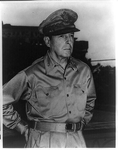Douglas MacArthur lived his entire life, from cradle to
grave, in the United States Army. The First World War gave Douglas
MacArthur his first real measure of fame. Quickly promoted to brigadier general,
he helped lead the Rainbow Division -- which he had helped create out of
National Guard units before the war -- through the thick of the fighting
in France. With a flamboyant, romantic style matched only by real feats
of courage on the battlefield, MacArthur became the most decorated American
soldier of the war. When war finally came with the blow at Pearl Harbor
on December 7, 1941, the Philippines was doomed: MacArthur's air force was
quickly destroyed, his army shredded, and by January his forces had retreated
to the Bataan peninsula, where they struggled to survive. President
Roosevelt knew he couldn't let America's most famous general fall to the
enemy. For the next three years, the world watched as his personal
quest -- "I shall return" -- became almost synonymous with the war in the
Pacific. Although MacArthur's path through the dense jungles of New Guinea
was hardly imagined in the initial war plans, his singleminded drive and
resourcefulness made it one of the two prongs in the Allied drive to roll
back the Japanese. His place as a leading figure of the 20th century
already secure, MacArthur may have made his greatest contribution to history
in the next five and a half years, as Supreme Commander of the Allied Powers
in Japan. After conflicts with Washington during the Korean War, the
old soldier "faded away" from the public eye, living quietly in New York
until his death in 1964.
